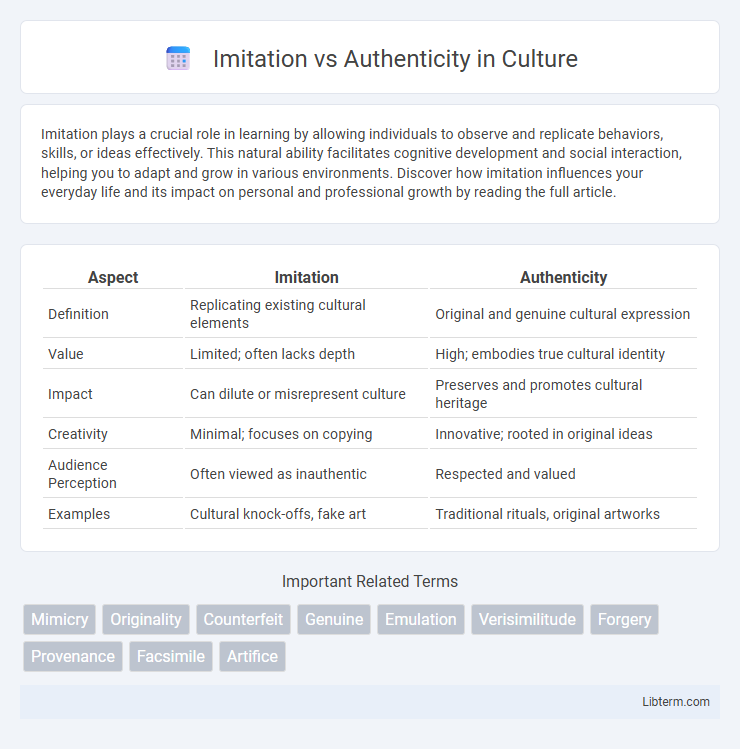Imitation plays a crucial role in learning by allowing individuals to observe and replicate behaviors, skills, or ideas effectively. This natural ability facilitates cognitive development and social interaction, helping you to adapt and grow in various environments. Discover how imitation influences your everyday life and its impact on personal and professional growth by reading the full article.
Table of Comparison
| Aspect | Imitation | Authenticity |
|---|---|---|
| Definition | Replicating existing cultural elements | Original and genuine cultural expression |
| Value | Limited; often lacks depth | High; embodies true cultural identity |
| Impact | Can dilute or misrepresent culture | Preserves and promotes cultural heritage |
| Creativity | Minimal; focuses on copying | Innovative; rooted in original ideas |
| Audience Perception | Often viewed as inauthentic | Respected and valued |
| Examples | Cultural knock-offs, fake art | Traditional rituals, original artworks |
Understanding Imitation and Authenticity
Imitation involves replicating behaviors, styles, or ideas often to learn or fit in, while authenticity reflects genuine expression aligned with one's true self and values. Understanding imitation requires recognizing its role in skill development and social adaptation, yet authenticity emphasizes originality, integrity, and personal truth. Balancing both concepts enhances creativity and self-awareness in personal and professional contexts.
Historical Perspectives on Authenticity
Historical perspectives on authenticity reveal evolving criteria used to evaluate originality in art, literature, and cultural artifacts. During the Renaissance, authenticity was often linked to the faithful imitation of classical forms, while the Romantic era emphasized individual expression and originality as the true markers of authenticity. In contemporary scholarship, authenticity is increasingly understood as a dynamic construct influenced by context, cultural values, and historical reinterpretations rather than fixed, objective standards.
The Psychology Behind Imitation
Imitation serves as a fundamental mechanism in human learning and social development, driven by mirror neurons that enable individuals to replicate observed behaviors. This psychological process fosters connection and identity formation but can blur boundaries between genuine self-expression and mimicry. Understanding the balance between imitation and authenticity reveals insights into self-concept and social conformity dynamics.
Cultural Influences on Authentic Expression
Cultural influences shape authentic expression by embedding unique traditions, languages, and social norms into artistic and personal identities, creating varied authentic experiences across societies. Imitation often lacks the depth derived from cultural context, making it difficult to replicate the genuine emotional and symbolic significance embedded in authentic works. Understanding how culture informs authenticity enhances appreciation for original expression and highlights the limitations of mere imitation.
Social Media: Amplifying Imitation or Authenticity?
Social media platforms often amplify imitation as users mimic trending content to gain visibility, leveraging algorithmic preferences for popular formats. However, authenticity can drive stronger engagement through genuine storytelling and unique perspectives, fostering deeper connections with audiences. Brands and influencers who balance relatable authenticity with strategic trends achieve sustainable growth and trust.
The Role of Originality in Creative Industries
Originality drives competitive advantage in creative industries by fostering unique content that resonates with audiences and builds lasting brand identities. Imitation often leads to market saturation and diminished consumer interest, whereas authentic innovation stimulates cultural evolution and economic growth. Emphasizing originality encourages creators to develop distinctive styles and ideas, enhancing both artistic value and commercial success.
Imitation as a Learning Tool
Imitation serves as a fundamental learning mechanism by enabling individuals to observe and replicate expert behaviors, thus accelerating skill acquisition and mastery. Neuroscientific studies demonstrate that mirror neurons activate during imitation, reinforcing neural pathways associated with the observed actions and improving cognitive development. This method builds a foundational understanding that authenticity can later personalize, fostering creativity and original thought.
Challenges of Maintaining Authenticity
Maintaining authenticity poses significant challenges as individuals navigate the pressure to conform and the temptation to imitate prevailing trends, which can dilute genuine self-expression. The constant exposure to curated social media personas fosters comparison, making it difficult to preserve personal integrity without succumbing to external influences. Authenticity requires conscious effort to balance societal expectations with self-awareness and resilience against imitation-driven homogenization.
Benefits and Pitfalls of Imitation
Imitation can accelerate learning by allowing individuals to replicate successful behaviors and strategies, leading to skill development and innovation through adaptation. However, excessive reliance on imitation may hinder creativity and individual expression, causing stagnation and a lack of genuine originality. Balancing imitation with authentic contributions fosters growth while preserving unique perspectives essential for personal and professional success.
Striking a Balance: Embracing Authenticity in an Imitative World
Striking a balance between imitation and authenticity requires recognizing the value of originality while learning from others' successes. Embracing authenticity fosters genuine connections and long-term credibility, differentiating individuals or brands in a crowded market. Prioritizing unique perspectives and personal values enables sustainable growth amid widespread imitation pressures.
Imitation Infographic

 libterm.com
libterm.com